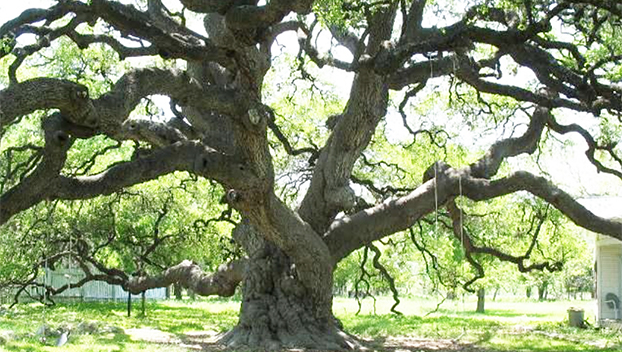MASTER GARDENER — This is why Autumn is the time to transplant trees
Published 12:26 am Thursday, September 8, 2022

- Live oak tree with an enormous crown spreading more than 200 feet. (Image courtesy Pintrest.com)
|
Getting your Trinity Audio player ready...
|
Can you believe we are now more than halfway through hurricane season 2022?
Fortunately, there have been no tropical storm developments within the Gulf of Mexico so far, and I’m going to “knock on wood,” ancient superstition or not!
Hurricanes not only damage homes, buildings and other structures but severely damage plants, especially trees. Often, trees appear to weather tropical storms and hurricanes with minimal damage from high winds and excessive rainfall, then a year or two afterward, trees simply die off.
I can attest to losing approximately 30 percent of trees that were toppled over from a combination of saturated soil and high winds, or large branches broken during high winds, which allowed disease to manifest.
Fall is the perfect opportunity to transplant trees; it’s time to recoup what we have lost.
Trees are an incredibly important aspect of our environment, providing food, such as fruit and nuts, lumber for building, pulp for paper, but also habitats for thousands of insect, bird, and animal species.
According to the Arbor Day Foundation, “a mature tree extracts more than 48 pounds of carbon dioxide from the atmosphere and releases oxygen in exchange.” Trees do more for us than give us food, building material and oxygen. They provide us shade, which helps cool the earth.
Most of a tree’s growth occurs during the spring and summer months, while there is an abundance of sunshine. As days grow shorter in fall, trees are alerted and begin making ready for winter, with leaves changing color from green turning red, orange, gold and brown, because with less sunlight and water for photosynthesis, the green chlorophyll begins to disappear.
As winter approaches, trees use less food stored from summer entering a rest period (dormancy). There are two different types of trees, deciduous and evergreen.
Deciduous trees, such as oak trees, lose their leaves in fall and remain bare throughout winter. Evergreen trees, such as pine trees, don’t lose their leaves simultaneously, but always keep some leaves on their branches, so they look like they are full.
They lose a few everyday with new leaves replacing the old, almost immediately.
Parts of a Tree: Crown (Branches & Leaves), Trunk and Roots
The top of the tree or crown is made up of branches and leaves. Branches provide support and distribute leaves efficiently for tree type. They are also conduits for water, nutrients, and storage of extra sugar (carbohydrates).
Leaves take the energy from the sun and convert it into sugar (food) for the tree. Leaves are the “food factories” for the tree, containing chlorophyll, which gives the leaves their green color. It is very important in photosynthesis, as the leaves use the suns energy to convert carbon dioxide from the atmosphere and water from the soil into sugar and oxygen. The sugar is stored in the tree’s branches, trunks and roots and the oxygen is released back into the atmosphere.
The roots are the parts of the tree growing beneath the soil. Trees have enormous number of root systems; in fact, the number of roots is similar the number of leaves, limbs and branches combined. It requires a lot of roots to hold upright a 100-foot tree. Roots have three purposes: structure (hold tree upright), collection (water and nutrients from the soil), and storage (water and nutrients for later use).
The trunk of the tree is an integrated structure anchored by the roots while supporting the crown. It also transports water and nutrients to and from the soil and sugar from the leaves. A trees’ trunk is comprised of 5 parts: bark (inner & outer), cambium, sapwood (xylem), heartwood and pith.
Trees with the highest wind resistance (University of Florida 10-year study)
The University of Florida researched wind tolerant trees in communities that received hurricane force winds between 1992-2005, identifying several trees, which appear to be somewhat resistant to wind damage. It is thought that the growth (form) of the trees helped them resist wind better.
Plant trees in groups of five rather than individual trees and plant a diversity of species and sizes/age groups. Creating a wind resistant tree canopy includes planting more of the wind tolerant trees and removal of the wind intolerant trees, especially if they are likely to cause property damage.
Fellow gardeners let’s grow ourselves a greener, more sustainable world, one plant (or tree), at a time!
John Green is a Certified Texas Master Gardener. If you have gardening questions or need more information, contact the Orange County Master Gardeners Helpline at 409-882-7010 or visit txmg.org/orange, Orange County Texas Master Gardeners Association on Facebook or email extension@co.orange.tx.us.




